Equality in Income and Sustainability in Economic Growth: Agent-Based Simulations on OECD Data
Abstract
1. Introduction
1.1. Global Trends and Country-Specific Characteristics of Growing Income Inequality
1.2. Economic Growth and Income Distribution
1.3. Why Agent-Based Simulations?
2. Overview of the Model Structure and Procedures for Modeling and Conducting Simulations
3. Method of Building a Simulation Model as an Economic System 1: The Decision-Making in the Three Sectors
3.1. Decision-Making in the R & D Sector
3.2. Decision-Making in the Private Business Sector
3.3. Decision-Making in the Inter-System Control Sector
4. Method of Building a Simulation Model as an Economic System 2: The Internal Organizational Structure and the Related Assumptions in the Three Sectors
4.1. Assumptions about Scarcity and Productivity of Knowledge Stock
4.2. The Internal Structure in the R & D Sector: The Generation Process of Knowledge Stock and Assumptions about Gain Structure
4.3. The Internal Structure in the Private Business Sector: Diminishing Marginal Propensity to Consume and Income Distribution
4.3.1. The Generation Process of Consumption Demand and Investment Demand
4.3.2. Income Distribution System and Consumer Demand
4.3.3. Consumption Structure with a Diminishing Marginal Propensity to Consume
4.4. Internal Structure in the Inter-System Control Sector: the Generation Process of Gross Product Equivalent
5. Results
5.1. Prerequisites: Setting Parameters and Initial Values for Variables
5.2. Simulation Results (1): Basic Trends in the Model
5.3. Simulation Results (2): Growth Potential Based on Actual Data of OECD Countries
- The United Kingdom and the United States, with their high marginal propensity to consume in excess of 0.6;
- low-lying countries, centered on northern Europe are 0.4 over to 0.5 under;
- and middle-ranking countries are 0.5 over to 0.6 under, including France, Germany, and Switzerland, and in between.
6. Discussion
6.1. Usefulness and Requirements of Agent-Based Simulation
- (1)
- We can produce results that are consistent with reality, although social phenomena, unlike natural phenomena, are not reproducible;
- (2)
- we can reproduce in a limited sense a real phenomenon that is difficult to explain using existing mathematical theories;
- (3)
- we can obtain satisfactory simulation results that are not to be arbitrary due to multiple parameter tunings;
- (4)
- we can evaluate the validity of the results based on the applied theory, the basis of the implementation function, etc.; and
- (5)
- we can approach problems that are difficult to explain using existing mathematical theories.
6.2. Evidence-Based Policy Recommendations that Do Not Require Social Experiments
6.2.1. Policy Recommendation 1: High Growth Path with Equality or Unstable Path with Inequality in the Consumption-Led Economy (US, UK, and Japan)?
6.2.2. Policy Recommendation 2: Stable and Moderate Growth Path even with Inequality in an Investment-Led Economy (Luxembourg and Norway)
6.2.3. Policy Recommendation 3: Equalization of the Income Distribution When of the Generation of Technological Innovation
Funding
Conflicts of Interest
Appendix A
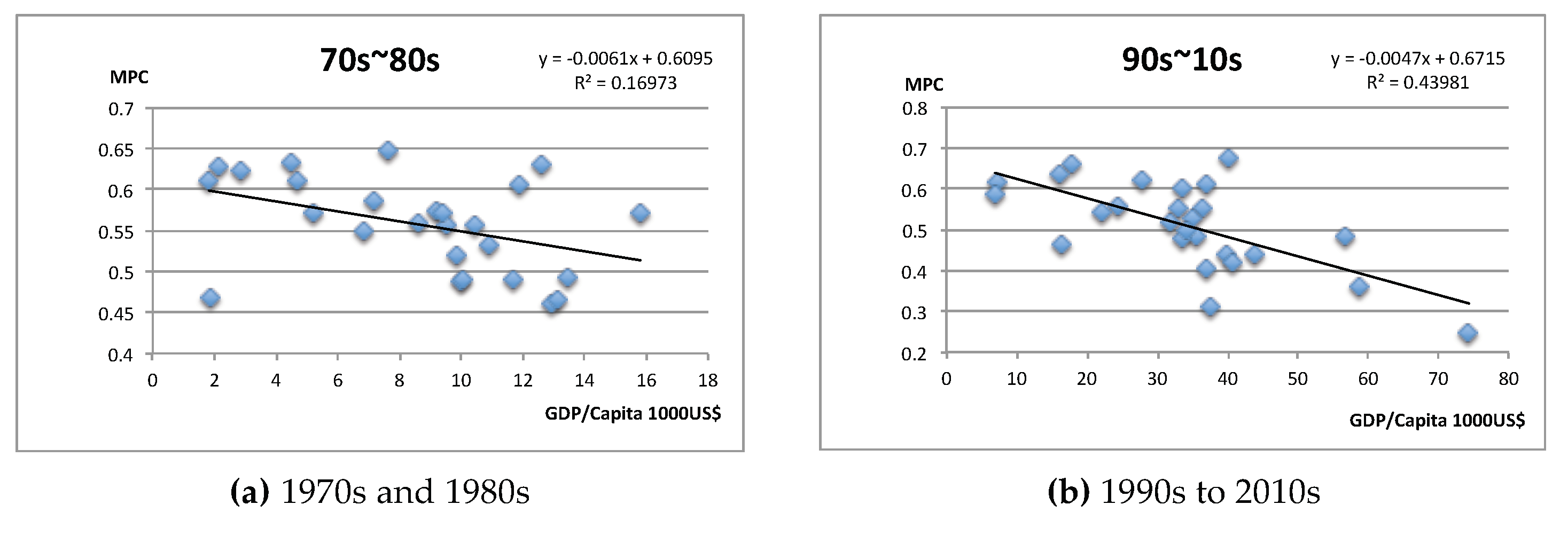
Appendix B
- (1)
- In the case of Y = 0.The assumptions (A1) and (A2) and the definitions (A3) and (A4) make the following relationships:
- (2)
- In the case of Y > 0.The assumption (A1) makes the following relationships:
References
- Arrow, K.J. Social Choice and Individual Values, 2nd ed.; Yale University Press: New Haven, CT, USA, 1970. [Google Scholar]
- Sen, A. Collective Choice and Social Welfare, 2nd ed.; Penguin: London, UK, 2017. [Google Scholar]
- Piketty, T. Capital in the Twenty-First Century, 3rd ed.; Misuzu Shobo: Tokyo, Japan, 2008. [Google Scholar]
- Shiga, S. Tax Haven; Iwanami Shoten: Tokyo, Japan, 2013. [Google Scholar]
- Shiga, S. Tax Eater; Iwanami Shoten: Tokyo, Japan, 2014. [Google Scholar]
- Shiga, S. Tax Observer; NP Tsushin-Sya: Tokyo, Japan, 2015. [Google Scholar]
- Ramsey, F.P. A Mathematical Theory of Savings. Econ. J. 1928, 38, 543–559. [Google Scholar] [CrossRef]
- Koopmans, T.C. On the Concept of Optimal Economic Growth. Cowles Foundation Discussion Papers. 1965. No.163. Available online: http://cowles.yale.edu/sites/default/files/files/pub/d01/d0163.pdf (accessed on 18 October 2019).
- Cass, D. Optimum Growth in an Aggregative Model of Capital Accumulation. Rev. Econ. Stud. 1965, 32, 233–240. [Google Scholar] [CrossRef]
- Uzawa, H. Optimum Technical Change in an Aggregative Model of Economic Growth. Int. Econ. Rev. 1965, 6, 18–31. [Google Scholar] [CrossRef]
- Samuelson, P.A. An Exact Consumption-Loan Model of Interest with or without the Social Contrivance of Money. J. Political Econ. 1958, 66, 467–482. [Google Scholar] [CrossRef]
- Diamond, P.A. National Debt in a Neoclassical Growth Model. Am. Econ. Rev. 1965, 55, 1126–1150. [Google Scholar]
- Blanchard, O.J.; Fischer, S. Lectures on Macroeconomics; MIT Press: Cambridge, MA, USA, 1989. [Google Scholar]
- Azariadis, C. Intertemporal Macroeconomics; Blackwell: Oxford, UK, 1993. [Google Scholar]
- Romer, P.M. Increasing Returns and Long-Run Growth. J. Political Econ. 1986, 94, 1002–1037. [Google Scholar] [CrossRef]
- Iwai, K. Economic Growth Theory. In Modern Economic Theory; Iwai, K., Ito, M., Eds.; University of Tokyo Press: Tokyo, Japan, 1994; pp. 265–324. [Google Scholar]
- Department of National Accounts, Economic and Social Research Institute, Cabinet Office, Government of Japan. Annual Report on National Accounts; Media Land Co., Ltd.: Tokyo, Japan, 2006.
- Aghion, P.; Tirole, J. The Management of Innovation. Q. J. Econ. 1994, 109, 1185–1209. [Google Scholar] [CrossRef]
- Aghion, P.; Tirole, J. Opening the Black Box of Innovation. Eur. Econ. Rev. 1994, 38, 701–710. [Google Scholar] [CrossRef]
- Beath, J.; Katsoulacos, Y.; Ulph, D. Game-Theoretic Approaches to the Modeling of Technological Change. In Handbook of the Economics of Innovation and Technological Change; Stoneman, P., Ed.; Blackwell: Oxford, UK, 1995; pp. 132–181. [Google Scholar]
- Goodacre, A.; Tonks, I. Finance and Technological Change. In Handbook of the Economics of Innovation and Technological Change; Stoneman, P., Ed.; Blackwell: Oxford, UK, 1995; pp. 298–341. [Google Scholar]
- Cooper, R.; John, A. Coordinating Coordination Failures in Keynesian Models. Q. J. Econ. 1988, 103, 441–463. [Google Scholar] [CrossRef]
- Ohtake, F.; Takenaka, S. Attitudes on Income Inequality: Comparison between Japan and the U.S. In Current Trends in Modern Economics 2007; Ichimura, H., Ed.; Toyo Keizai Inc.: Tokyo, Japan, 2007; pp. 67–99. [Google Scholar]
- Tachibanaki, T. Inequality: What’s the Problem? Iwanami Shoten: Tokyo, Japan, 2006. [Google Scholar]
- Ferreira, H.G.; Ravallion, M. Global Poverty and Inequality: A Review of the Evidence. World Bank Policy Research Working Paper. 2008. WPS4623. Available online: http://documents.worldbank.org/curated/en/801061468138860309/pdf/wps4623.pdf (accessed on 18 October 2019).
- Kuriyama, K.; Ibaraki, H.; Takahashi, K.; Ueda, H.; Inoue, T. Consideration of Public Awareness of Benefits and Burdens; Discussion Paper; Cabinet Office Government of Japan: Tokyo, Japan, 2005; Volume 5, pp. 441–463.
- Folster, S.; Henrekson, M. Growth Effects of Government Expenditure and Taxation Rich Countries. Eur. Econ. Rev. 2001, 45, 1501–1520. [Google Scholar] [CrossRef]
- Morikawa, M. On the Trade-Off between Efficiency and Equity: Observed Facts Based on Survey Data. RIETI Discussion Paper Series. 2001. 08-J-036. Available online: https://www.rieti.go.jp/jp/publications/dp/08j036.pdf. (accessed on 18 October 2019).
- Aghion, P.; Caroli, E.; Garcia-Penalosa, C. Inequality and Economic Growth: The Perspective of the New Growth Theories. J. Econ. Lit. 1999, 37, 1615–1660. [Google Scholar] [CrossRef]
- Björklund, A.; Freeman, R. Searching for Optimal Inequality/Incentives. NBER Working Paper. 2008. No. 14014. Available online: https://www.nber.org/papers/w14014.pdf (accessed on 18 October 2019).
- Voitchovsky, S. Inequality and economic growth. In The Oxford Handbook of Economic Inequality; Salverda, W., Nolan, B., Smeeding, T.M., Eds.; Oxford University Press: Oxford, UK, 2009; pp. 549–574. [Google Scholar]
- Kuroda, M. For the preparation of input-output tables (2). Innov. IO Tech. 1992, 3, 40–47. [Google Scholar]
- Kuroda, M.; Nomura, K. Productivity Comparison and International Competitiveness in Japan and the United States. Mita Bus. Rev. 1999, 42, 74. [Google Scholar]
- Nakamura, Y. Introduction to SNA Statistics; Nikkei Publishing Inc.: Tokyo, Japan, 1999. [Google Scholar]
- Cabinet Office. Available online: https://www.esri.cao.go.jp/index-e.html (accessed on 2 October 2019).
- Leontief, W. Factor Proportions and Structure of American Trade: Further Theoretical and Empirical Analysis. Rev. Econ. Stat. 1956, 38, 386–407. [Google Scholar] [CrossRef]
- Statistics Bureau of Japan. Available online: https://www.stat.go.jp/english/index.html (accessed on 2 October 2019).
- Nakajima, T.; Kitamura, Y.; Kimura, F.; Shimbo, K. Textbook of Economic Statistics; TOYO KEIZAI Inc.: Tokyo, Japan, 2000. [Google Scholar]
- Friedman, M. Essays in Positive Economics; University of Chicago Press: Cambridge, MA, USA, 1953. [Google Scholar]
- Aoki, M. Organization and Information of Japanese Companies; TOYO KEIZAI Inc.: Tokyo, Japan, 1989. [Google Scholar]
- Aoki, M. Institutional Analysis of the Japanese Economy: Information, Incentive and Bargaining Game; Chikumashobo Ltd.: Tokyo, Japan, 1992. [Google Scholar]
- Aoki, M. Introduction to Comparative Institutional Analysis: Economic System Evolution and Diversity: Economic System Evolution and Diversity; Toyo Keizai Inc.: Tokyo, Japan, 1995. [Google Scholar]
- Ito, M. Strategic trade policy and trade issues. In Modern Economic Theory; Iwai, K., Ito, M., Eds.; University of Tokyo Press: Tokyo, Japan, 1994; pp. 139–179. [Google Scholar]
- Matsushima, H. The Past, the Present, and the Future: Repeated Games and Economics. In Modern Economic Theory; Iwai, K., Ito, M., Eds.; University of Tokyo Press: Tokyo, Japan, 1994; pp. 57–102. [Google Scholar]
- Stoneman, P. Handbook of the Economics of Innovation and Technological Change; Blackwell: Oxford, UK, 1995. [Google Scholar]
- Iwai, K. The Bootstrap Theory of Money—A Search-Theoretic Foundation of Monetary Economics. Struct. Chang. Econ. Dyn. 1996, 7, 451–477. [Google Scholar] [CrossRef]
- Kiyotaki, N. Theory of money and credit. In Modern Economic Theory; Iwai, K., Ito, M., Eds.; University of Tokyo Press: Tokyo, Japan, 1994; pp. 181–210. [Google Scholar]
- Shiozawa, Y. Heritage of Marx; Fujiwara-Shoten: Tokyo, Japan, 2002. [Google Scholar]
- Takagi, H.; Kijima, K.; Deguchi, H. People and Society in the Multimedia Age; Union of Japanese Scientists and Engineers: Tokyo, Japan, 1995. [Google Scholar]
- Terano, T. Why Agent-Based Modeling in Social System Analysis? Transdiscipl. Fed. Sci. Technol. 2010, 4, 56–62. [Google Scholar]
- Axelrod, R. The Complexity of Cooperation, Agent-Based Models of Competition and Collaboration; Princeton University Press: Princeton, NJ, USA, 1997. [Google Scholar]
- Fudenberg, D.; Tirole, J. Game Theory; MIT Press: Cambridge, MA, USA, 1991. [Google Scholar]
- Deguchi, H. Creation of agent-based social systems science. Inf. Process. 2005, 46, 508–514. [Google Scholar]
- Axelrod, R. Advancing the Art of Simulation in the Social Sciences. In Simulating Social Phenomena; Conte, R., Ed.; Springer: New York, NY, USA, 1997; pp. 21–40. [Google Scholar]
- Terano, T. Agent-based modeling, beyond KISS principles. Trans. Jpn. Soc. Artif. Intell. 2003, 18, 710–715. [Google Scholar]
- Axtell, T. Why Agents? On the Varied Motivation for Agent Computing in the Social Sciences. Brookings Institution CSED Technical Report. 2000. No. 17. Available online: https://www.brookings.edu/wp-content/uploads/2016/06/agents.pdf (accessed on 18 October 2019).
- Sakaki, S. A Method of Building Simulation Model for Organizational Decision-making and Inter-organizational Control. Evol. Inst. Econ. Rev. 2018, 15, 289–313. [Google Scholar] [CrossRef]
- Sakaki, S. Management Model for Technological Change and Sustainable Growth. Evol. Inst. Econ. Rev. 2004, 1, 107–125. [Google Scholar] [CrossRef]
- Sakaki, S. Income Distribution Management to Sustain Long-Term Economic Growth: Does the Equalization of Income Distribution Contribute to Long-Term Economic Growth? Evol. Inst. Econ. Rev. 2017, 14, 363–395. [Google Scholar] [CrossRef]
- Deguchi, H. Economics of Complex Systems; Union of Japanese Scientists and Engineers: Tokyo, Japan, 2000. [Google Scholar]
- Cantner, U.; Savin, I.; Vannuccini, S. Replicator dynamics in value chains: Explaining some puzzles of market selection. Ind. Corps Chang. 2019, 28, 589–611. [Google Scholar] [CrossRef]
- Yoshikawa, H. Modern Macroeconomics; Sobunsha: Tokyo, Japan, 2000. [Google Scholar]
- Weibull, J.W. Evolutionary Game Theory; MIT Press: Cambridge, MA, USA, 1995. [Google Scholar]
- Scherer, F.M. New Perspectives on Economic Growth and Technological Innovation; Brookings Institution Press: Washington, DC, USA, 1999. [Google Scholar]
- Keynes, J.M. The General Theory of Employment, Interest, and Money; Prometheus Books Published: New York, NY, USA, 1997; p. 120. [Google Scholar]

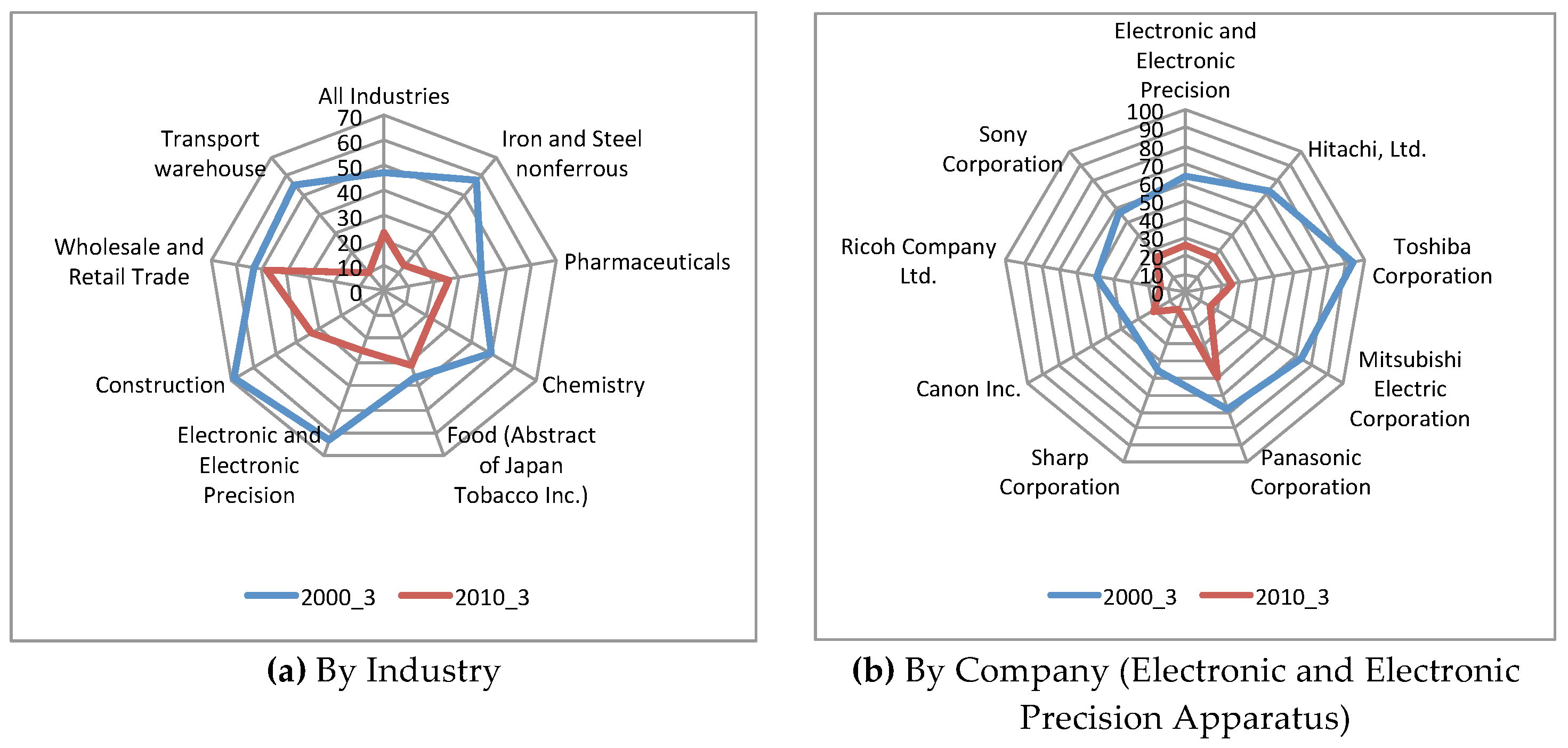
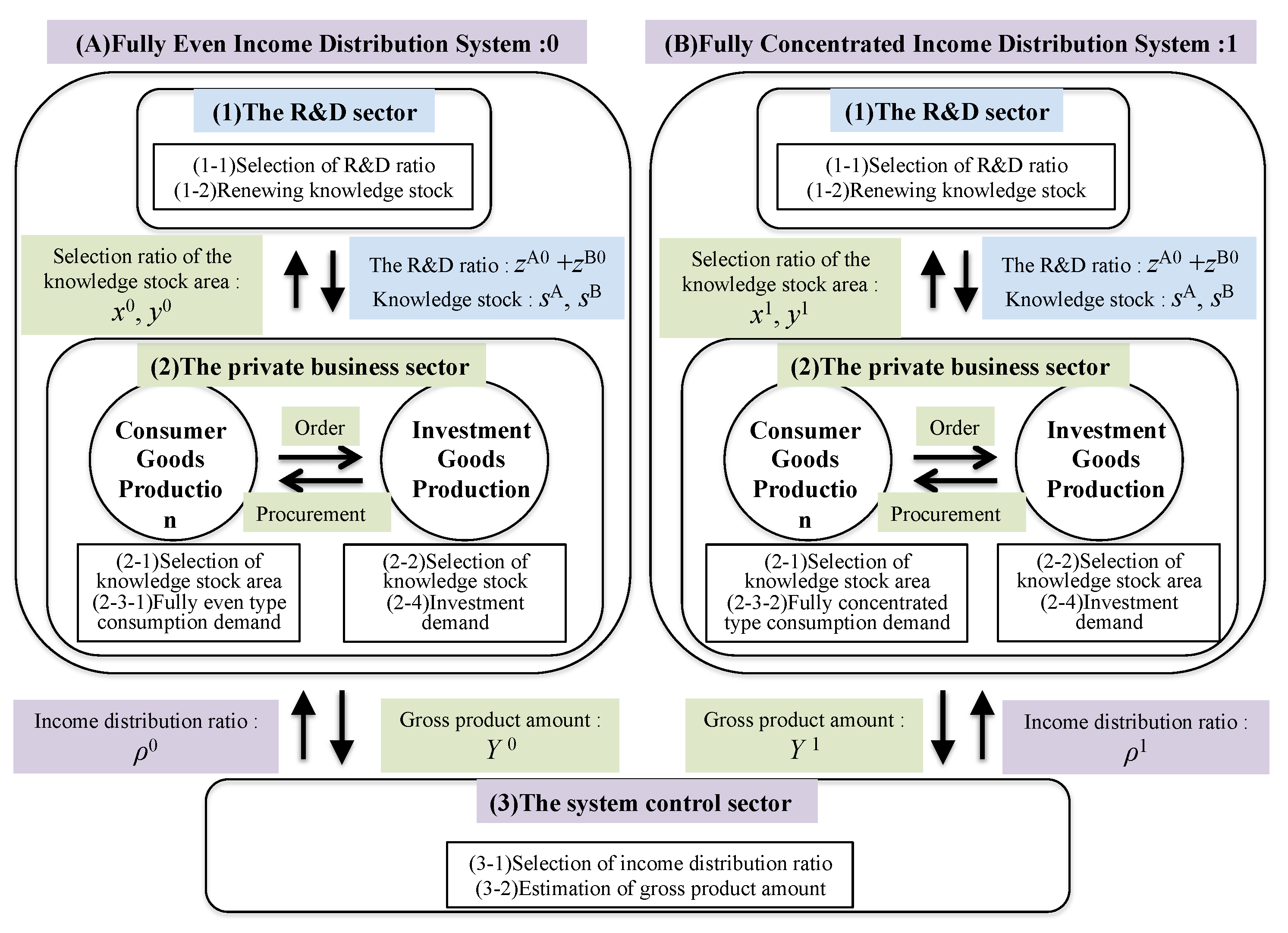
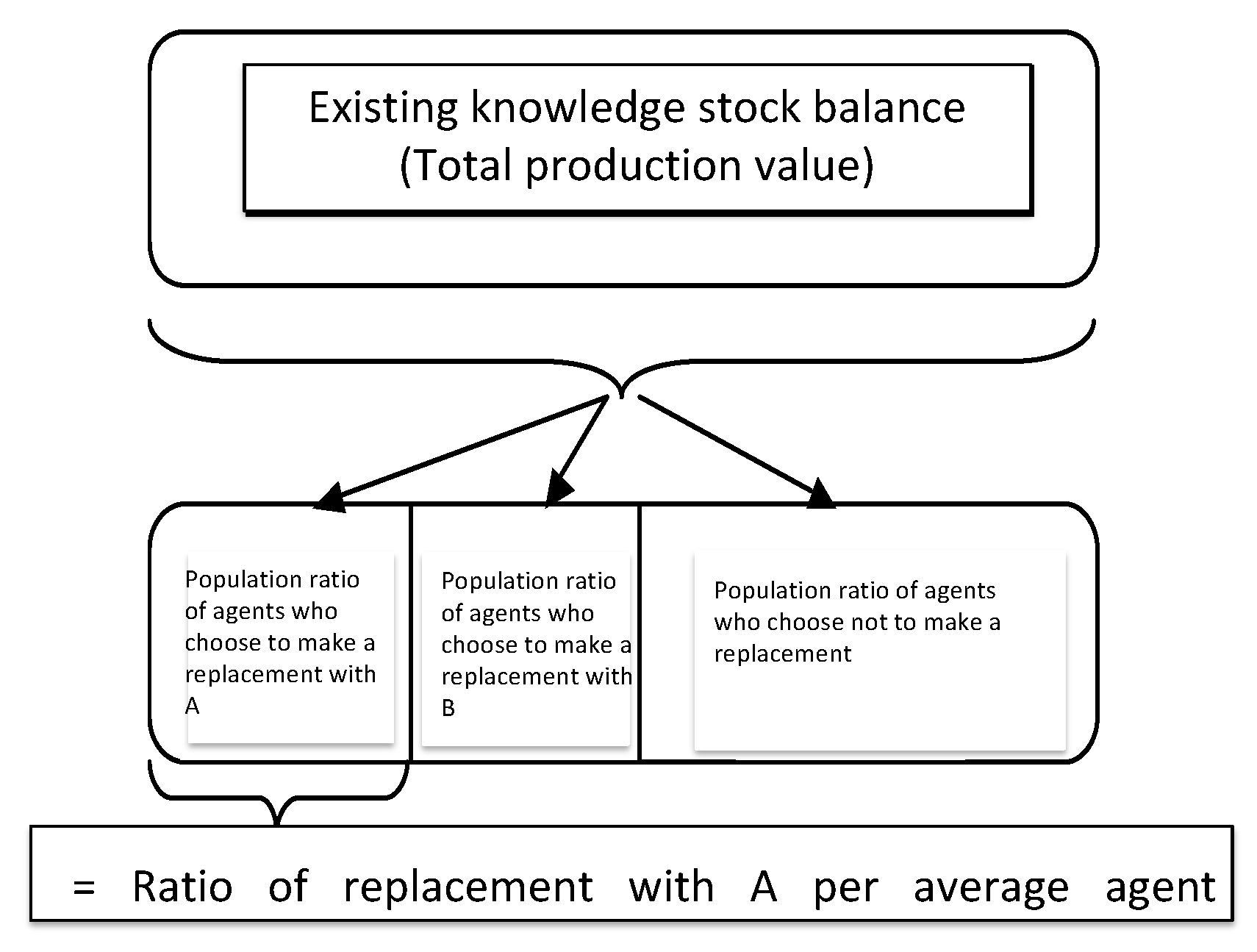
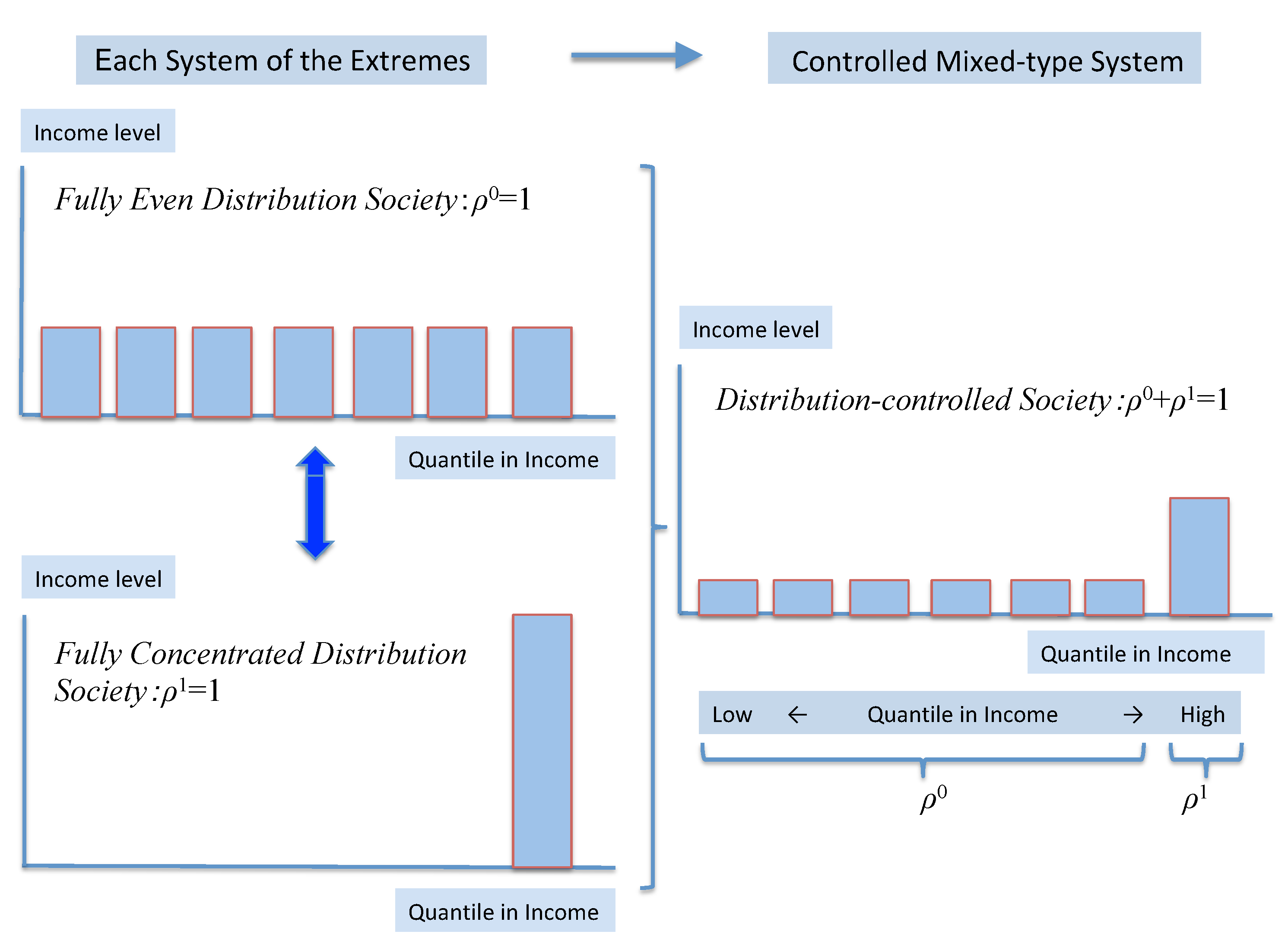
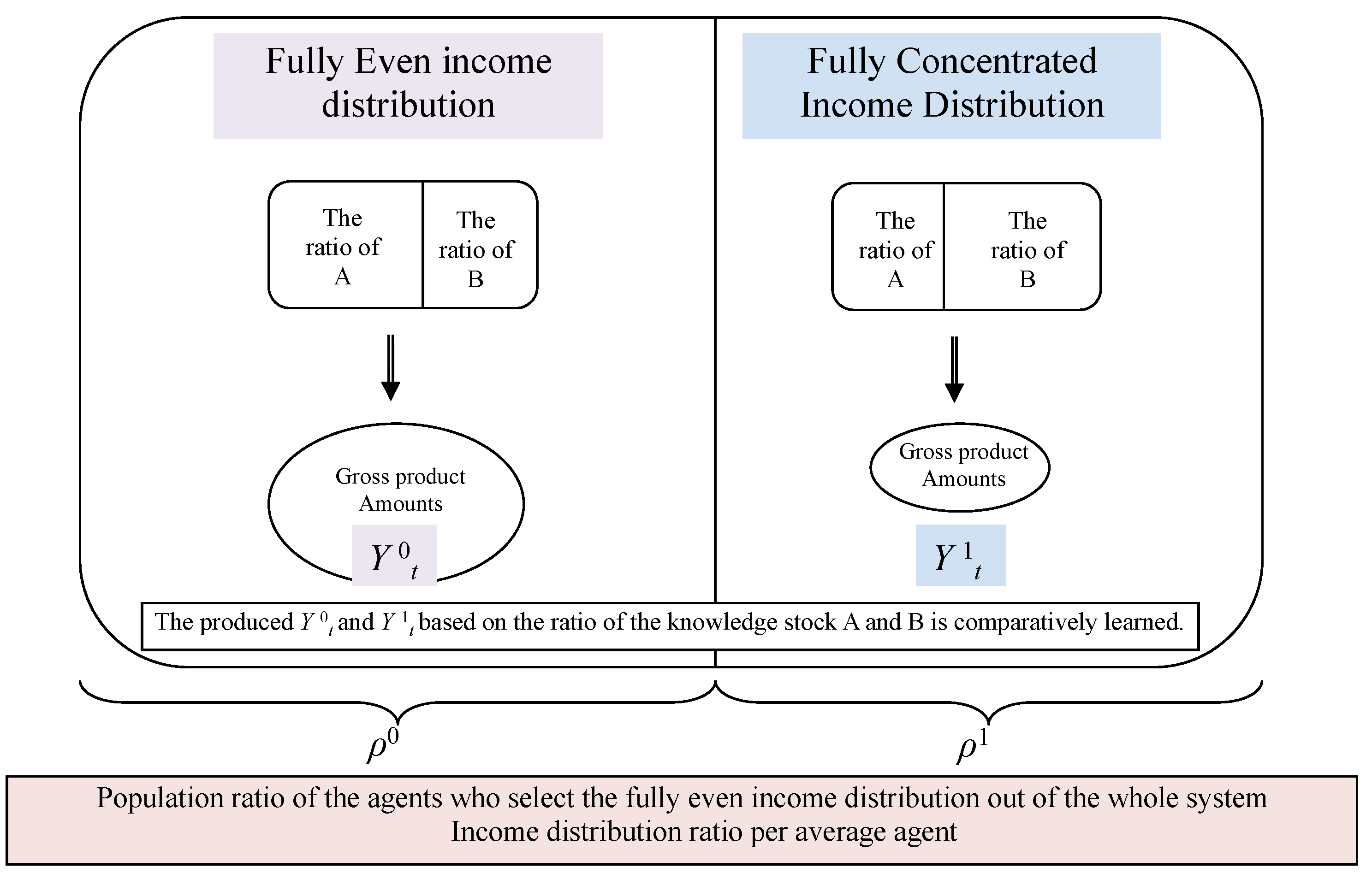
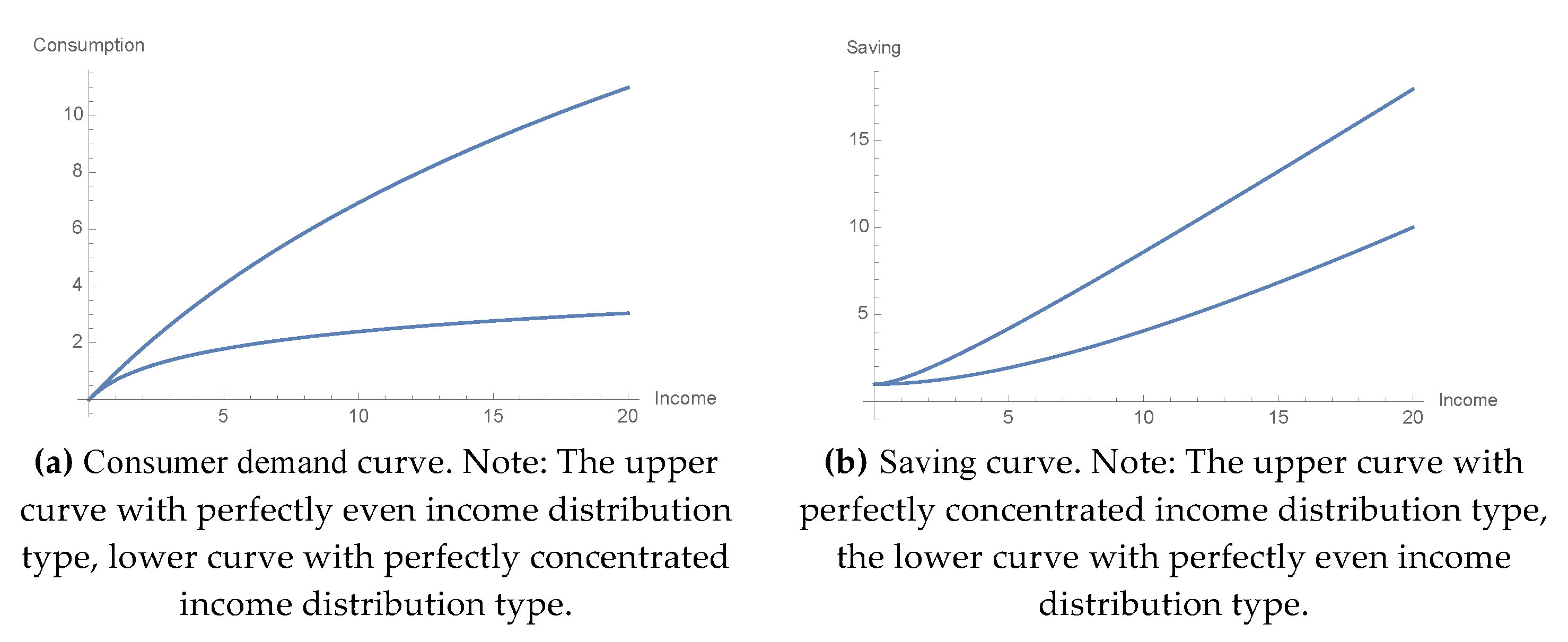


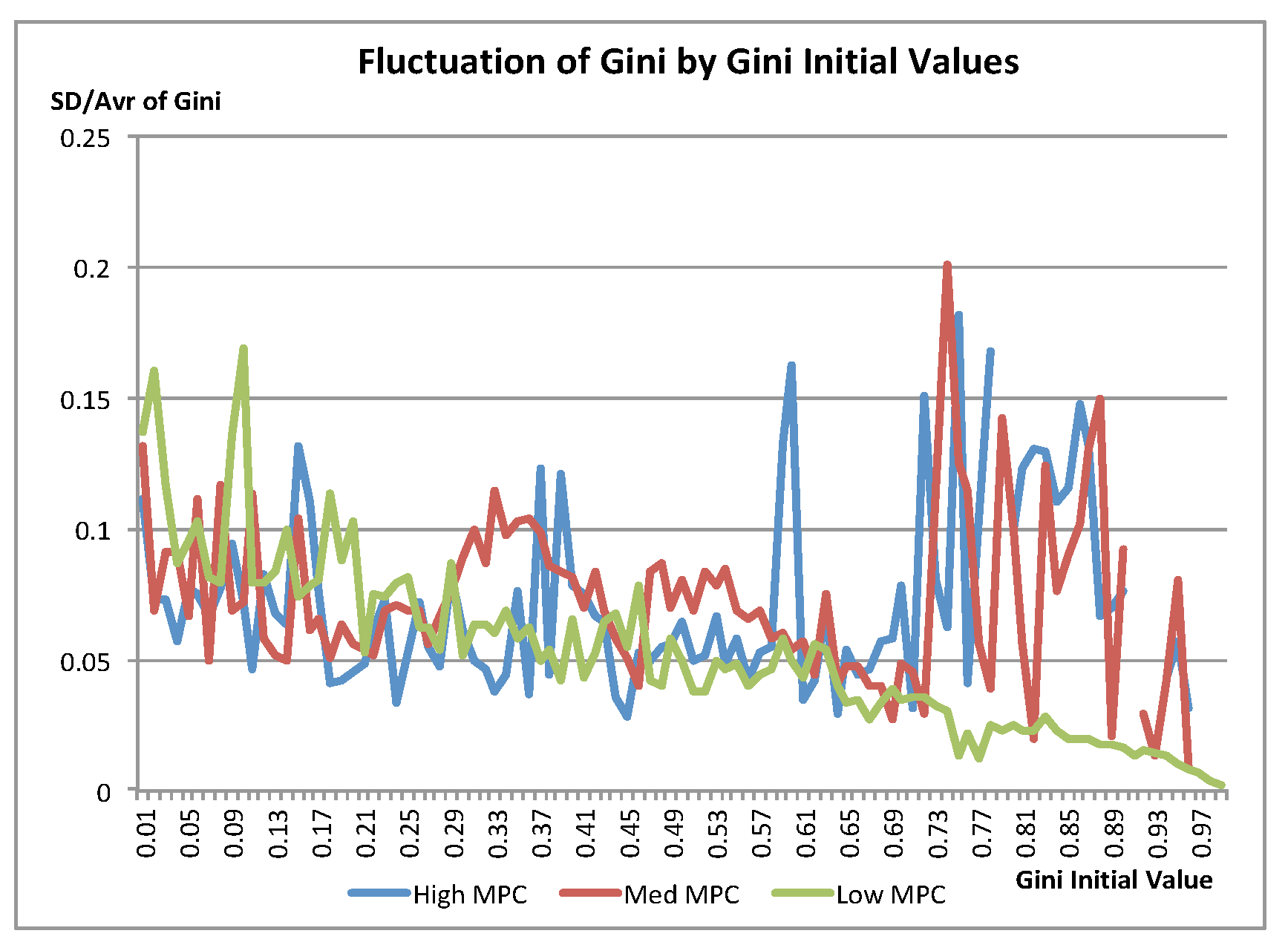

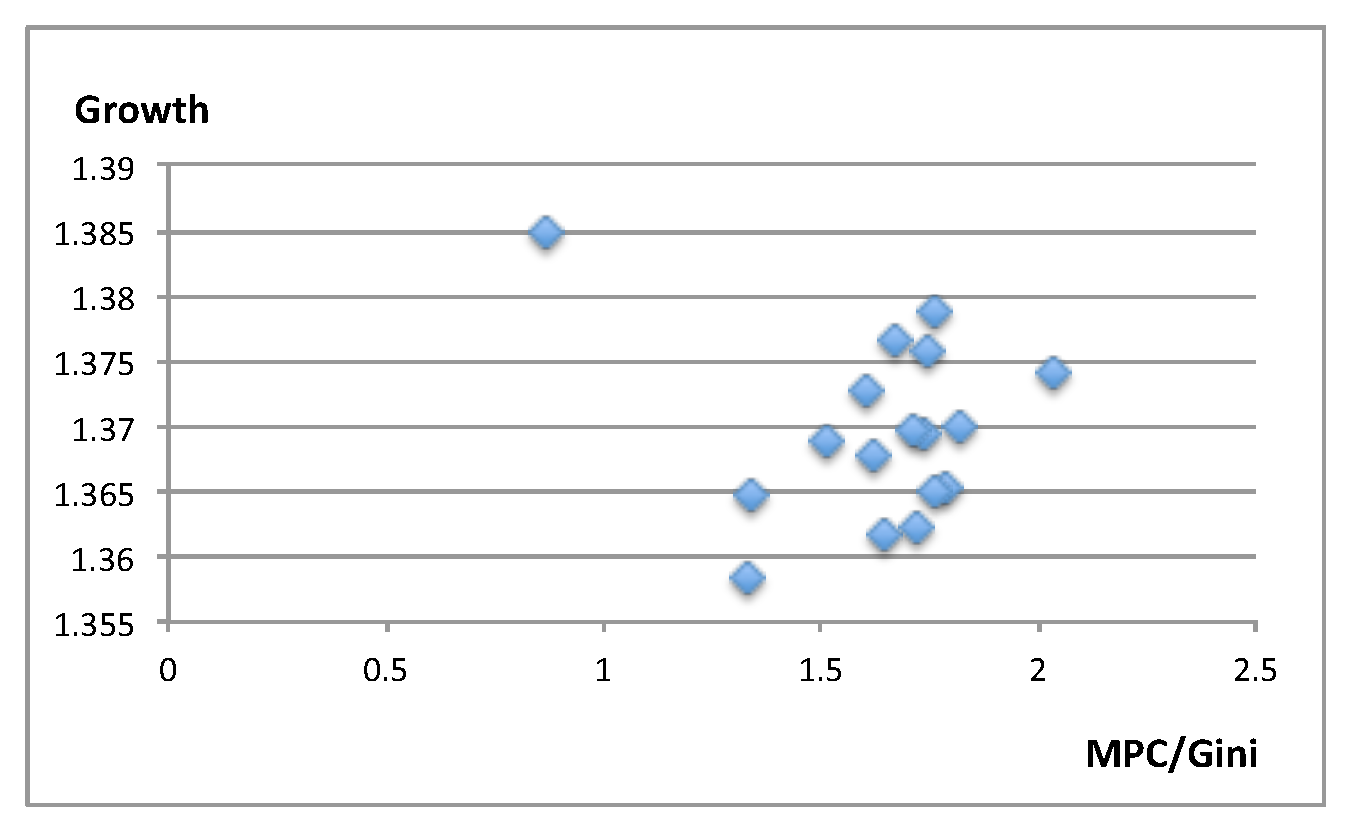
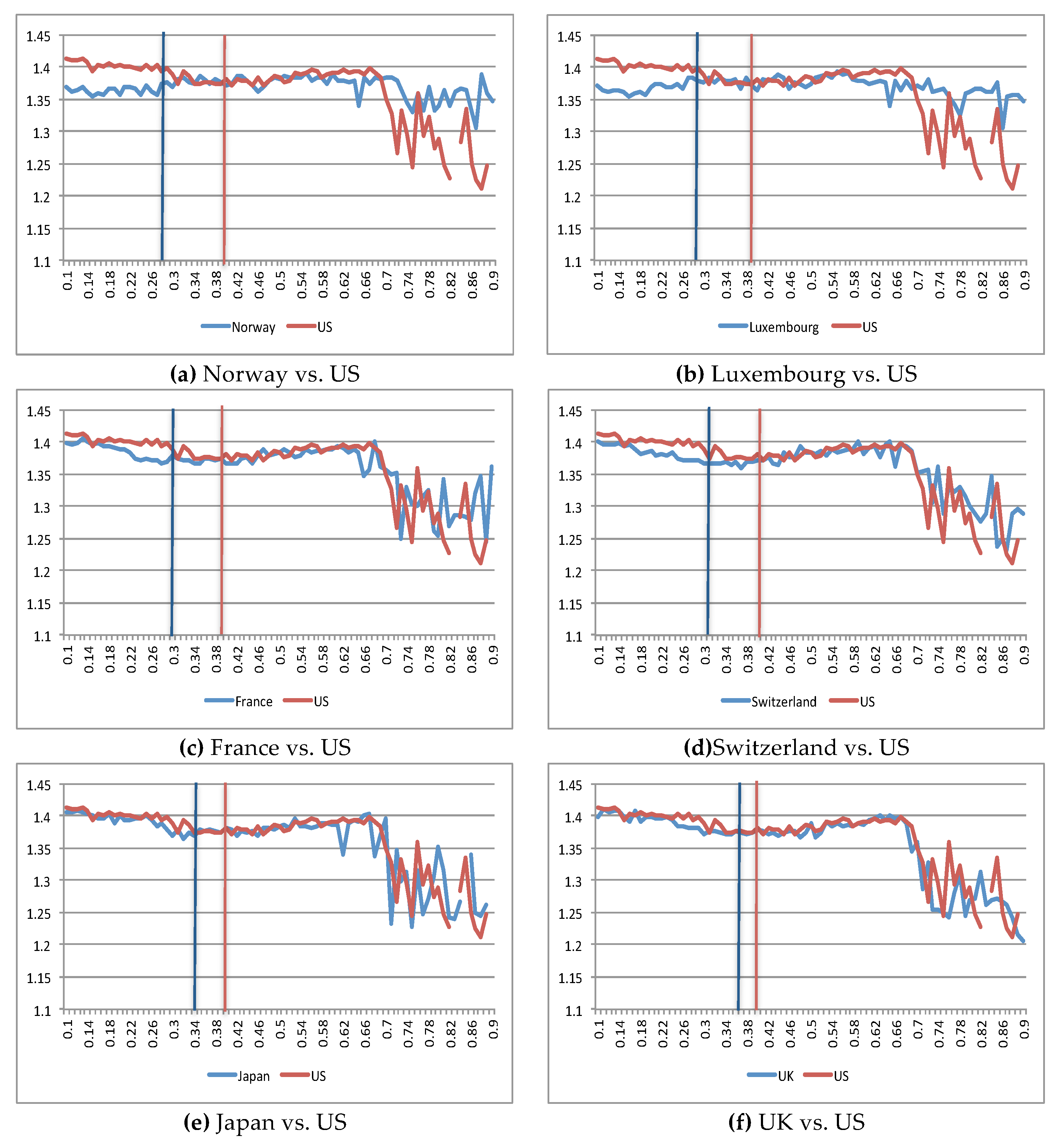
| Chapters and Sections of Text | Numbers in Figure 3 | Procedures to Conduct Modeling and Simulation |
|---|---|---|
| Section 3 | Definition of sectors and economic variables in this model. | |
| 3.1 | (1), (1-1) | R & D Sector: Determine R & D ratio. |
| 3.2 | (2) | Private Business Sector: Selection of knowledge stock areas. |
| 3.2 | (2-1) | Consumer Goods Production Division: Selection on the basis of consumption demand. |
| 3.2 | (2-2) | Investment Goods Production Division: Selection on the basis of investment demand. |
| 3.3 | (3-1) | Inter-System Control Sector: Selection of the income distribution system. |
| Section 4 | Definition of gains as a decision criterion in each sector | |
| 4.1 | (1) | R & D Sector: Definition of the relationship between productivity and scarcity of knowledge stock. |
| 4.2 | (1-2) | Specific definitions of each knowledge stock balance after R & D update. |
| 4.3 | (2) | Specific definitions of consumer and investment demand |
| 4.3.1 | (2) | Induction of demand for consumption and investment common to the two virtual income distribution systems. |
| 4.3.2 | (2-3-1) | Definition of consumption demand in a perfectly even income distribution system |
| 4.3.2 | (2-3-2) | Definition of consumption demand in a perfectly concentrated income distribution system |
| 4.3.2 | (2-4) | Definition of investment demand in both systems |
| 4.3.3 | (2) | Examples of differences in levels between the two systems for consumer demand and investment demand |
| 4.4 | (3-2) | Inter-System Control Sector: Specific definition of gross product amounts under each virtual system and real system |
| Section 5 | Procedures and results of simulations. | |
| 5.1 | Setting of structural parameters and initial values for the model. | |
| 5.2 | Simulations for three stylized cases. | |
| 5.3 | Simulations for OECD nations. | |
| Section 6 | Discussions on appropriateness of income distribution policy recommendation. |
| MPC | Gini | Population (1K) | Growth | |||
|---|---|---|---|---|---|---|
| 70s~80s | 90s~10s | 2015 | 2016 | 70s~80s | 90s~10s | |
| United Kingdom | 0.646465217 | 0.601914206 | 0.36 | 65,789 | 7.957648279 | 4.126458311 |
| United States | 0.630394714 | 0.677171909 | 0.39 | 322,180 | 8.651048175 | 4.319499858 |
| Belgium | 0.574421456 | 0.47800158 | 0.268 | 11,358 | 8.005920041 | 4.008065682 |
| Switzerland | 0.572077173 | 0.482664205 | 0.297 | 8402 | 6.973479037 | 4.03100397 |
| Germany | 0.570529126 | 0.495904766 | 0.289 | 81,915 | 7.815166096 | 3.767644771 |
| Austria | 0.559876905 | 0.485363264 | 0.276 | 8712 | 8.192717705 | 4.212858548 |
| Australia | 0.556005234 | 0.554664879 | 0.337 | 24,126 | 8.478227701 | 5.271908232 |
| France | 0.555354334 | 0.518755819 | 0.295 | 64,721 | 8.399057604 | 3.848739998 |
| New Zealand | 0.547902397 | 0.559156682 | 0.349 | 4661 | 7.634287798 | 5.023491742 |
| Canada | 0.532391844 | 0.553760096 | 0.318 | 36,290 | 8.856135173 | 4.07049973 |
| Japan | 0.520242224 | 0.610375596 | 0.336 | 126,933 | 9.816553768 | 2.867719949 |
| Luxembourg | 0.492793775 | 0.24632912 | 0.284 | 576 | 9.021792787 | 6.390966269 |
| Denmark | 0.490763018 | 0.440207624 | 0.256 | 5712 | 7.498641034 | 4.408167217 |
| Netherlands | 0.490074326 | 0.406882642 | 0.303 | 16,987 | 7.935791594 | 4.307330483 |
| Finland | 0.487236623 | 0.52907638 | 0.26 | 5503 | 8.949807544 | 3.772866889 |
| Sweden | 0.466007749 | 0.419781897 | 0.278 | 9838 | 7.488521911 | 4.004401052 |
| Norway | 0.460740222 | 0.36105076 | 0.272 | 5255 | 9.070635952 | 5.25636354 |
| MPC | Population (1K) | Gini | Growth | |
|---|---|---|---|---|
| 90s~10s | 2016 | 2015 | (Calculated) | |
| United Kingdom | 0.601914206 | 65,789 | 0.36 | 1.37651 |
| United States | 0.677171909 | 322,180 | 0.39 | 1.36934 |
| Japan | 0.610375596 | 126,933 | 0.336 | 1.37 |
| Belgium | 0.47800158 | 11,358 | 0.268 | 1.36529 |
| Switzerland | 0.482664205 | 8402 | 0.297 | 1.3678 |
| Germany | 0.495904766 | 81,915 | 0.289 | 1.36972 |
| Austria | 0.485363264 | 8712 | 0.276 | 1.36496 |
| Australia | 0.554664879 | 24,126 | 0.337 | 1.36162 |
| France | 0.518755819 | 64,721 | 0.295 | 1.37868 |
| New Zealand | 0.559156682 | 4661 | 0.349 | 1.3728 |
| Canada | 0.553760096 | 36,290 | 0.318 | 1.37564 |
| Finland | 0.52907638 | 5503 | 0.26 | 1.37403 |
| Luxembourg | 0.24632912 | 576 | 0.284 | 1.38491 |
| Denmark | 0.440207624 | 5712 | 0.256 | 1.36221 |
| Netherlands | 0.406882642 | 16,987 | 0.303 | 1.36485 |
| Sweden | 0.419781897 | 9838 | 0.278 | 1.36873 |
| Norway | 0.36105076 | 5255 | 0.272 | 1.35832 |
© 2019 by the author. Licensee MDPI, Basel, Switzerland. This article is an open access article distributed under the terms and conditions of the Creative Commons Attribution (CC BY) license (http://creativecommons.org/licenses/by/4.0/).
Share and Cite
Sakaki, S. Equality in Income and Sustainability in Economic Growth: Agent-Based Simulations on OECD Data. Sustainability 2019, 11, 5803. https://doi.org/10.3390/su11205803
Sakaki S. Equality in Income and Sustainability in Economic Growth: Agent-Based Simulations on OECD Data. Sustainability. 2019; 11(20):5803. https://doi.org/10.3390/su11205803
Chicago/Turabian StyleSakaki, Shungo. 2019. "Equality in Income and Sustainability in Economic Growth: Agent-Based Simulations on OECD Data" Sustainability 11, no. 20: 5803. https://doi.org/10.3390/su11205803
APA StyleSakaki, S. (2019). Equality in Income and Sustainability in Economic Growth: Agent-Based Simulations on OECD Data. Sustainability, 11(20), 5803. https://doi.org/10.3390/su11205803





